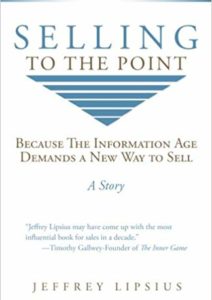Sales trainers, you must keep one very important thing in mind—customers don’t attend your training, only salespeople attend. This seems like an obvious statement, but many sales trainers don’t act as if they understand this. It means all sales trainers are faced with a significant limitation. They can only influence what salespeople are going to say. They can’t influence how customers are going to respond. The trainer’s intentions are good, but can result in putting salespeople at a distinct disadvantage. Few customers respond the way they’re supposed to. Salespeople are left having to abandon their training and they flounder.
Speaking of flounder, here’s my suggestion—don’t give salespeople fish, teach them how to fish. Bad joke aside, my point is that salespeople need to be more clued into their customers than clued into their training. If a salesperson is thinking about their training scripts while talking to customers, he/she is going to be distracted. If you’re a customer, wouldn’t you want salespeople paying full attention to you rather than thinking about their training?
The source of a salesperson’s learning should be customer derived rather than trainer derived. Higher performing salespeople observe their customers more keenly. Keen observation accelerates a salesperson’s ability to learn things such as a their customer’s beliefs, values, challenges, objectives, priorities, and much more. Better learning leads to better performance. How we perform is dependent upon how we learn.
The most successful sales trainers will foster a salesperson’s learning from customer interactions, rather than from sales meetings. This, by the way, is why I chose to write my sales training book as a fiction story with a plot rather than using an instructional format. I thought a better learning medium is from conversations between the characters.
A great start for sales training effectiveness is to sharpen salespeople’s inquiry skills. Well-posed questions can reveal mountains of information about a customer’s decision process. Sales professionals must never forget that the goal of selling is buying. Buying is also known as decision-making, and it’s an internal process. By asking questions, salespeople can create a window into the internal process of customer decision-making.
Salespeople can also use questions to redirect their customer’s attention. Paying attention to the right factors leads to better decisions. Salespeople have had the benefit of previous experiences with other customers who bought their product. They watched and learned which considerations those customers took into account that led to the best decisions. Salespeople can help new customers by asking questions that will redirect their attention toward those same valuable considerations.
A salesperson’s conversation with his or her customer is the real classroom. Make sales training experiential. Hands on exercises such as role-playing, and simulated selling experiences are much more valuable. Keep lecturing to a minimum.
Sales trainers need to put their egos aside and encourage salespeople to learn from the best teacher of all—the customer. This can be done in the classroom with experiential exercises like role-playing and selling simulations. Keeping a salesperson’s eye on the ball, adds a crucial level of clarity to sales training which benefits everyone.
Pipeliner CRM empowers salespeople to maintain precise customer data so can always be used.Get your free trial of Pipeliner CRM now.













Comments